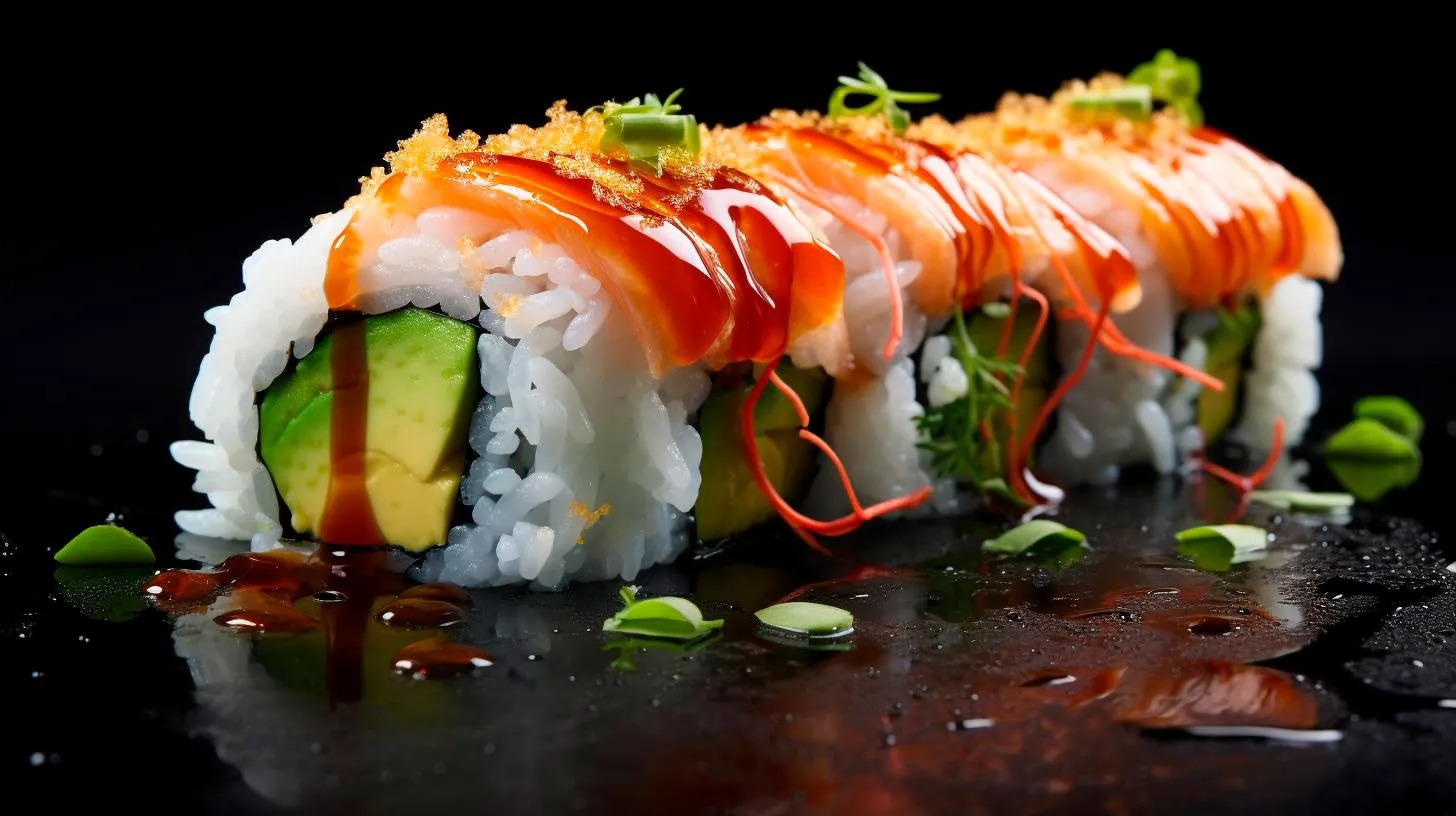Sushi-Centric Flavor Enhancers: Elevating Your Sushi Experience to New Heights
These ingredients elevate each sushi bite, tantalizing taste buds and creating unforgettable culinary journeys. In this article, we explore some sushi-centric flavor enhancers that are sure to take your sushi experience to new heights.
1. Wasabi: The Fiery Green Elixir
When it comes to sushi condiments, wasabi undoubtedly takes the crown. This fiery green paste is made from the root of the Wasabia japonica plant and adds a bold, distinctive flavor to sushi. Wasabi not only provides a sharp, tingling sensation on the palate but also has antibacterial properties believed to cleanse the palate between different varieties of sushi.
Sushi lovers, both traditionalists and experimentalists, appreciate the creativity that can be unleashed by wasabi. Its versatility allows for a myriad of flavor combinations, making each bite a unique adventure. Whether mixed directly with soy sauce or carefully applied between the fish and rice, wasabi guarantees a fiery kick that enhances the overall taste experience.
2. Pickled Ginger: A Palate Cleanser
No sushi platter is complete without a side of pickled ginger, known as gari in Japanese. This thinly sliced ginger is soaked in vinegar, giving it a tangy and refreshing flavor that acts as a palate cleanser between different sushi bites. The purpose of gari is to cleanse the taste buds, allowing the full flavors of each piece of sushi to shine through.
Ginger is not only a palate cleanser but also has various health benefits. It aids digestion, reduces nausea, and even has anti-inflammatory properties. Apart from its practical uses, the vibrant pink hue of pickled ginger adds a touch of visual appeal to the sushi plate, further enhancing the overall dining experience.
3. Sesame Seeds: The Nutty Crunch
Adding a delightful crunch to your sushi rolls, sesame seeds are a popular and versatile sushi flavor enhancer. These tiny, nutty seeds come in various colors, such as white, black, and even red. They not only lend a pleasing texture but also present a mild, earthy aroma to complement the sushi’s flavors.
Sesame seeds are a rich source of essential nutrients, including healthy fats, fiber, and antioxidants. Incorporating sesame seeds into your sushi is an excellent way to add a healthy twist to your meal. Whether sprinkled on top of a California roll or used as a coating for rice balls, sesame seeds bring a unique element to the sushi experience.
4. Tamari Soy Sauce: Glazing Sushi with Umami
Soy sauce has long been a staple condiment for sushi enthusiasts, but tamari soy sauce takes it to the next level. Tamari is a gluten-free version of traditional soy sauce, originating from Japan. It has a thicker consistency, a richer flavor, and a higher concentration of umami, which is the fifth basic taste in addition to sweet, sour, salty, and bitter.
When dipping sushi into tamari soy sauce, the umami taste profile accentuates the flavors of the fish, rice, and other ingredients wrapped within. A little goes a long way, as the concentrated flavor quickly enhances the overall taste experience. Tamari soy sauce is also an excellent alternative for those with gluten sensitivities.
5. Yuzu: The Citrus Zing
Yuzu is a citrus fruit that originates from East Asia, known for its refreshing aroma and tangy flavor. Its zest and juice are widely used to enhance various dishes, including sushi. The addition of yuzu adds a vibrant citrusy zing to sushi, balancing the flavors and brightening the overall taste profile.
Yuzu is not only a flavor booster but also boasts health benefits. It is rich in vitamin C and antioxidants, which can support the immune system and promote overall well-being. For those seeking a unique twist to their sushi, yuzu-infused soy sauce or a yuzu-based dressing drizzled over sushi rolls can create a truly sensational experience.
Key Takeaways:
- Wasabi adds a fiery kick and versatility to sushi, enhancing the overall taste experience.
- Pickled ginger serves as a palate cleanser and aids digestion, while adding visual appeal.
- Sesame seeds bring a nutty crunch and a healthy twist to sushi with their nutrient-rich composition.
- Tamari soy sauce, with its thicker consistency and higher umami content, elevates the flavors of sushi.
- Yuzu, a citrus fruit, adds a refreshing zing to sushi, along with health benefits and unique flavor.
By incorporating these sushi-centric flavor enhancers into your dining experience, you can elevate each sushi bite to new heights. From the fiery kick of wasabi to the vibrant zing of yuzu, these flavor enhancers add depth, complexity, and excitement to your sushi journey. Embrace the creativity and explore the endless combinations – each sushi roll becomes a canvas for your taste buds to savor.
A Symphony on the Palate
How do different flavors interact with each other, and how do chefs and scientists come together to create the perfect harmony on our palates?
In this article, we will delve into the fascinating world of taste, exploring the science behind flavor pairing and the art of creating exquisite culinary delights. Prepare to embark on a journey that will expand your understanding of taste, and perhaps even inspire you to experiment in your own kitchen.
The Science of Flavors
Flavor pairing is not just about randomly combining ingredients; it is an intricate science that involves understanding the chemical compounds responsible for taste. The taste we perceive is a result of how our taste buds detect specific molecules in food. These molecules interact with our taste receptors, sending signals to our brains that are translated into flavors.
One of the key principles in flavor pairing is the concept of complementary and contrasting flavors. Complementary flavors work together to enhance each other, creating a harmonious combination. For example, the bitterness of dark chocolate can be complemented by the sweetness of caramel, resulting in a balanced and enjoyable taste.
In contrast, contrasting flavors create a dynamic sensory experience by playing on the principle of opposites. Think of the classic combination of salty and sweet, such as salted caramel. The salty notes enhance the sweetness, creating a mouthwatering balance that keeps you coming back for more.
Creating Culinary Masterpieces
When it comes to creating culinary masterpieces, chefs are like conductors, orchestrating a symphony of flavors. They use their knowledge of flavor pairing to create dishes that not only taste incredible but also evoke emotions and memories. It’s a delicate balance of art and science.
One technique that chefs employ is the use of flavor profiles. A flavor profile is a breakdown of the different taste elements in a dish, such as sweet, sour, salty, bitter, and umami. By understanding the basic taste components, chefs can create dishes that are well-balanced and offer a range of flavors.
- Experimentation is key in the culinary world. Chefs are constantly pushing the boundaries of flavor pairing, combining unexpected ingredients to create new taste sensations.
- Food pairing is not limited to savory dishes. Pastry chefs also use flavor pairing to create delicious desserts that tantalize our taste buds.
- Understanding the cultural and regional aspects of flavors is crucial in creating authentic dishes. Each cuisine has its own unique flavor combinations that reflect the traditions and ingredients of the region.
Taking Your Palate on a Journey
Exploring different flavors and cuisines allows us to take our palates on a journey around the world. It broadens our horizons and opens up a world of sensory delights. Whether you choose to try exotic spices from India, delicate pastries from France, or spicy street food from Mexico, every bite is an opportunity to experience something new.
Not only does flavor pairing provide a feast for our taste buds, but it also offers a multitude of health benefits. Many ingredients used in flavor pairing are rich in antioxidants, vitamins, and other essential nutrients. For example, the pairing of tomatoes and olive oil not only creates a delicious combination but also provides a dose of heart-healthy fats and lycopene.
Key Takeaways
Next time you enjoy a scrumptious meal, take a moment to appreciate the symphony playing on your palate. Understand that behind every bite lies a fascinating world of science and creativity. Remember these key takeaways:
- Flavor pairing is based on the science of taste and involves the interaction of molecules with taste receptors.
- Chefs use flavor profiles to create well-balanced dishes that offer a range of taste sensations.
- Experimentation and cultural understanding are at the heart of flavor pairing, allowing chefs to create unique and authentic culinary experiences.
- Exploring different flavors and cuisines opens up a world of sensory delights and provides numerous health benefits.
So, go ahead and embark on your own flavor pairing adventure. Let your taste buds be your guide, and let the symphony on your palate transport you to a realm of culinary bliss.
Exploring Sushi Sauces Beyond Soy
In this article, we will take a deep dive into the world of sushi sauces beyond soy, exploring their flavors, advantages, and key takeaways.
The Magic of Sushi Sauces
Sushi sauces are like symphonies for your taste buds, adding depth and complexity to the already flavorful bite-sized rolls. They serve as a complement to the fish, rice, and other ingredients, providing a burst of umami or a hint of acidity. While soy sauce is undoubtedly a classic choice, expanding your horizons and experimenting with different sushi sauces can truly elevate your sushi game.
Beyond Soy: Exploring the Alternatives
1. Ponzu Sauce
Ponzu sauce is a citrus-based sauce made with a combination of soy sauce, rice vinegar, and yuzu juice. It offers a refreshing and tangy flavor profile that pairs exceptionally well with sashimi and delicate seafood. The citrusy notes cut through the richness of fish, adding a zesty kick.
- Advantages of Ponzu Sauce:
- Provides a bright and refreshing taste to sushi
- Helps in enhancing the flavor of delicate seafood
- Offers a lower sodium alternative to soy sauce
2. Eel Sauce
Eel sauce, also known as unagi sauce, is a thick, sweet, and savory glaze made from soy sauce, mirin, and sugar. This sauce is often used to drizzle over grilled eel nigiri or to add a hint of sweetness to other sushi rolls. Its caramelized flavor profile beautifully enhances the taste of sushi rice and adds a touch of indulgence.
- Advantages of Eel Sauce:
- Provides a sweet and savory flavor combination
- Enhances the taste of sushi rice
- Perfect for adding a touch of indulgence
3. Wasabi Mayo
Combine the traditional wasabi kick with creamy mayonnaise, and you get the flavorful and slightly spicy wasabi mayo. This sauce is a great choice for those who enjoy a creamy texture with a hint of heat. It complements both seafood and vegetable sushi rolls and adds a creamy element to your bites.
- Advantages of Wasabi Mayo:
- Blends the heat of wasabi with creaminess of mayonnaise
- Adds a unique and pleasant flavor to sushi rolls
- Perfect for those who enjoy a creamier texture
4. Spicy Mayo
Spicy mayo is a delightful combination of mayonnaise and spicy seasonings like Sriracha or chili sauce. It has become a favorite sauce for sushi lovers around the world, known for its creamy texture and spicy kick. This sauce pairs exceptionally well with ingredients like shrimp tempura and adds a burst of flavor to every bite.
- Advantages of Spicy Mayo:
- Provides a creamy texture with a spicy kick
- Enhances the flavor of sushi rolls
- Perfect for those who enjoy a spicy twist
Key Takeaways
Exploring sushi sauces beyond soy opens up a world of flavors and experiences. Here are the key takeaways:
- Sushi sauces add depth and complexity to sushi rolls.
- Try ponzu sauce for a refreshing and tangy taste.
- Indulge in the caramelized flavor of eel sauce.
- Experience the creamy heat of wasabi mayo.
- Enjoy the spicy kick of spicy mayo.
So, the next time you indulge in sushi, venture beyond the trusty soy sauce and explore new and exciting flavors with these delicious sushi sauces. Let your taste buds embark on an unforgettable culinary journey!
Harmonious Soy Sauce Alternatives
In this article, we will explore some of the best soy sauce alternatives available, their unique features, advantages, and key takeaways. So, let’s dive in and discover the world beyond soy sauce!
1. Tamari Sauce
Tamari sauce is a Japanese alternative to soy sauce with a rich, umami flavor. It is made from fermented soybeans but typically contains little to no wheat, making it suitable for gluten-free diets. Tamari sauce offers the following features, advantages, and key takeaways:
- Gluten-free option for individuals with wheat sensitivities or celiac disease.
- Rich and distinct taste, perfect for marinades, dressings, and dipping sauces.
- Excellent source of amino acids and minerals such as iron and manganese.
- Available in both regular and low-sodium options to suit various dietary needs.
2. Coconut Aminos
Coconut aminos is a soy-free alternative that offers a naturally sweet and slightly tangy flavor. It is made from the sap of coconut blossoms and is popular among those following soy-free and paleo diets. Consider these key features, advantages, and key takeaways when using coconut aminos:
- Free from soy and gluten, making it suitable for various dietary restrictions.
- Provides essential amino acids, vitamins, and minerals.
- Lower in sodium compared to traditional soy sauce.
- Enhances the taste of stir-fries, marinades, and Asian-inspired dishes.
3. Liquid Aminos
Liquid aminos is another popular alternative that is derived from soybeans but undergoes a different fermentation process than traditional soy sauce. While it contains soy, it is essentially free from wheat and gluten. Key features, advantages, and takeaways of liquid aminos include:
- Full-flavored seasoning that works well as a condiment or in cooking.
- Provides a diverse range of amino acids and nutrients.
- Low in calories and fat, ideal for those following a healthy lifestyle.
- Complements various cuisines, including Asian, Mexican, and Mediterranean.
4. Worcestershire Sauce
While Worcestershire sauce may not be an obvious choice as a soy sauce substitute, it can add a unique and tangy flavor to your dishes. While it does contain soy, it is not the main ingredient, and thus, it can be a suitable alternative for certain individuals. Consider these key features, advantages, and key takeaways:
- Complex flavor profile with a balance of tanginess, sweetness, and umami.
- Ideal for marinades, dressings, Bloody Mary cocktails, and meat dishes.
- Contains additional ingredients like vinegar, molasses, and tamarind for a distinctive taste.
- Offers an alternative for those who tolerate small amounts of soy in their diets.
Conclusion
Exploring soy sauce alternatives opens up new culinary possibilities for individuals with dietary restrictions or those wanting to experiment with different flavors. Whether you choose tamari sauce, coconut aminos, liquid aminos, or even Worcestershire sauce, each alternative brings its own unique qualities to the table.
Remember to consider factors like dietary restrictions, flavor profiles, and intended culinary use when selecting the most suitable soy sauce substitute. So, why limit yourself to traditional soy sauce when there are numerous harmonious alternatives available? Embark on a culinary adventure and let your taste buds explore a world beyond soy sauce!



